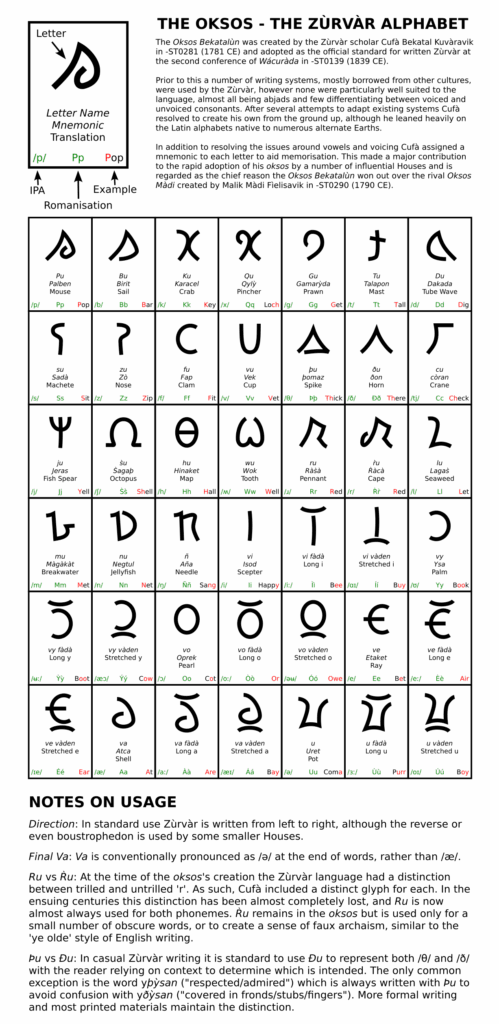Put here so I can find them easily…
Traditional Zurvár belief systems don’t have the concept of an all powerful deity. The closest equivalents would be either pak vâmâkan (‘the creator’ – the ancestor being said to have created the Zurvár race) or pak rèzaq (‘the wave’ – the spiritual plane to which certain components of the Zurvár soul are said to return to await reincarnation).
When discussing deities from non-Zurvár cultures the term báèsûad – ‘being of great power’ – is generally used. The term has no implication as to whether said powers are used for good or ill however, and would be used equally to describe (for instance) the Christian God and the Christian Devil.
When referring to a specific deity, a Zurvár rendering of the deity’s name is usually improvised. Examples from Earth’s religions include,
- Báèsûad Kot, Báèsûad Cesùs, Báèsûad Gris, Báèsûad Cùhová – The Christian God
- Báèsûad Alá, Báèsûad Alûá, Báèsûad Máhumd – Allah
- Báèsûad Ašem, Báèsûad Yáwe, Báèsûad Abráem – The Judaic God
- Báèsûad Pùdá, Báèsûad Pùd – Buddha
- Báèsûad Odin, Báèsûad Tâ, Báèsûad Loqè – Norse Gods/MCU Characters
The Zurvár creation myth is based around five elements, and these permeate most factors of their culture, including their traditional calendar. In order they’re lòtò (boats), minak (stars), katálá (fish), rindû (birds) and táká (knots).
The traditional calendar (as opposed to the revised calendar used on Zurvár Arèáná) uses a week (mán) of five days named after these elements (dásûln lòtò, dásûln minak, etc). A month (kadatán) consists of five weeks (25 days), each of which is also named after the five elements, and five months (125 days) – again named after the five elements – makes up a full year (rin).
A date is traditionally written with the full title of the day, week and month, followed by whatever system of year identification the House in question uses. The fourth day of the third week of the fifth month for instance would be dásûln rindû dámán katálá dákadatán táká. Even before the adoption of the revised calendar however it was more common to simply use numbers – for instance sûln tò-rû-zadat “day four three five”.
The combination of the day and month element of a person’s birth is said to predict their character, similarly to that of horoscopes here on Earth.
The calendar used on Zurvár Arèáná has a split derived from the Gregorian BCE/CE system, but in a slightly complicated way.
The Zurvár calendar is based on the calendar used by the Metaphysicians’ Guild, which itself is based on the Gregorian calendar. The epoch however is fixed to the start of the Gregorian century in which Zurvár Arèáná was settled – the 20th – so the zero year of the Zurvár calendar is 1900 CE.
As such the current year on Zurvár Arèáná is ST0123, which breaks down as…
- ST – Indicates that the Zurvár Arèáná epoch is being used
- 01 – It’s the second century of said epoch
- 23 – It’s the 23rd year of that century
Years prior to 1900 CE are indicated with a negative century indicator. 1788 CE for instance would be -ST0288.
The century indicator is written with a minimum of two characters, but can be expanded as necessary for dates in the distant past and distant future.
The Zurvár are humans originating from a nearby parallel Earth (although not even they can pin down their actual world of origin). They’re close enough to ‘standard’ humans to interbreed but have a number of evolutionary adaptations suited to their marine focused culture.
- Most Zurvár have webbing between their toes and fingers. On the toes this extends almost to the tips, on fingers it rarely extends beyond the first knuckle.
- Zurvár skin is more resistant to sunburn and is extremely resistant to UV induced cancers. It varies in tone between III and IV on the Fitzpatrick scale, but even the lightest shades almost never burn.
- Zurvár kidneys process dissolved salts far more efficiently, to the extent that a Zurvár can drink nothing but sea water for around a week before suffering any ill effects (as such, human visitors to Zurvár Arèáná should keep in mind that municipal water supplies may require additional filtration before being safe to consume).
- The Zurvár spleen is significantly larger than that of ‘standard’ humans, providing a larger reserve of oxygenated blood. This allows the average Zurvár to easily hold their breath for several minutes without discomfort, and remain submerged and active for anywhere up to 15 minutes. With practice Zurvár free divers routinely reach depths of 200 metres while remaining submerged for up to 40 minutes.
- Around 30% of Zurvár have epicanthic folds. Debate continues over whether this is some kind of adaptation to marine environments or simply the result of genetic drift across the historically nomadic Zurvár population.
